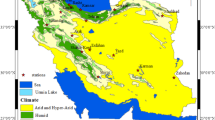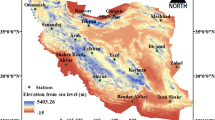Abstract
Drought forecasting and monitoring play a significant role in reducing the negative effects of global meteorological droughts caused by different intensities at different temporal and spatial scales in different regions, especially in regions with high dependency on rainwater. The present study tries to compare the accuracy of stationary time series (ST) models including autoregressive moving average (ARMA), moving average (MA) and autoregressive (AR) and cyclostationary time series (CT) models including periodic autoregressive moving average (PARMA), periodic moving average (PMA) and periodic autoregressive (PAR) to predict drought index (i.e. monthly reconnaissance drought index (RDI)) in periodic data series considering that CT models are more powerful and efficient than ST models by using data series of 8 synoptic stations with different climate conditions in Iran from 1967 to 2017. According to the results the monthly RDI was significantly periodic in all selected stations. The PAR (25) model was the best fitted CT model in data series at all stations and on the other hand, the following models were the best-fitted ST models in data series: the AR models at Babolsar and Rasht AR (25) and at Gorgan AR (24) and ARMA models at Tehran ARMA (2, 3), at Zahedan and Shiraz ARMA (2, 4) and at Esfahan and Shahre Kord ARMA (2, 5). Based on the best fitted CT and ST models, the results showed that the correlation coefficients (R) between observed and simulated RDI vary from 0.882 to 0.946 and from 0.693 to 0.874, respectively from January 1967 to December 2017. According to the best fitted CT and ST models, the validation test of the best fitted models indicated that the R between observed and simulated RDI vary from 0.634 to 0.883 and 0.585 to 0.847, respectively from January 2012 to December 2017. In total, it can be concluded that that the accuracy and capability of CT models in predicting the RDI were more than those of the ST models at all stations and the hypothesis of the study was confirmed.











Similar content being viewed by others
Data Availability
The was used data in this research will be available (by the corresponding author), upon reasonable request.
Abbreviations
- ST:
-
Stationary time series models.
- ARMA:
-
Autoregressive Moving Average.
- MA:
-
Moving Average.
- AR:
-
Autoregressive.
- CT:
-
Cyclostationary time series models.
- PARMA:
-
Periodic Autoregressive Moving Average.
- PMA:
-
Periodic Moving Average.
- PAR:
-
Periodic Autoregressive.
- RDI:
-
Reconnaissance Drought Index.
- SPI:
-
Standardized Precipitation Index.
- IMO:
-
Iran Meteorological Organization.
- PET:
-
Potential Evapotranspiration.
- ACF:
-
Autocorrelation Function.
- PACF:
- PEACF:
-
Periodic Autocorrelation Function.
- PEPACF:
-
Periodic Partial autocorrelation function
References
Abdourahamane ZS, Acar R (2019) Fuzzy rule-based forecast of meteorological drought in western Niger. Theor Appl Climatol 135(1–2):157–168
Adede C, Oboko R, Wagacha P, Atzberger C (2019) A mixed model approach to drought prediction using artificial neural networks: case of an operational drought monitoring environment. arXiv preprint arXiv:1901.04927
Adarsh S, Janga Reddy M (2019) Evaluation of trends and predictability of short-term droughts in three meteorological subdivisions of India using multivariate EMD-based hybrid modelling. Hydrol Process 33(1):130–143
Alwan IA, Ziboon ART, Khalaf AG (2019) Utilization of reconnaissance drought index (RDI) for monitoring of meteorological drought over middle Euphrates region during the period from 1988 to 2017. In IOP Conference Series: Materials Science and Engineering (Vol. 518, no. 2, p. 022035). IOP publishing
Arnone E, Cucchi M, Dal Gesso S, Petitta M, Calmanti S (2020) Droughts prediction: a methodology based on climate seasonal forecasts. Water Resources Management:1–16. https://doi.org/10.1007/s11269-020-02623-3
Ashraf S, AghaKouchak A, Nazemi A, Mirchi A, Sadegh M, Moftakhari HR, Hassanzadeh E, Miao CY, Madani K, Baygi MM, Anjileli H (2019) Compounding effects of human activities and climatic changes on surface water availability in Iran. Clim Chang 152(3–4):379–391
Aronson EL, Goulden ML, Allison SD (2019) Greenhouse gas fluxes under drought and nitrogen addition in a Southern California grassland. Soil Biol Biochem 131:19–27
Baik J, Zohaib M, Kim U, Aadil M, Choi M (2019) Agricultural drought assessment based on multiple soil moisture products. J Arid Environ 167:43–55
Dehghan S, Salehnia N, Sayari N, Bakhtiari B (2020) Prediction of meteorological drought in arid and semi-arid regions using PDSI and SDSM: a case study in Fars Province, Iran. Journal of Arid Land 12:318–330
Dilling L, Daly ME, Kenney DA, Klein R, Miller K, Ray AJ, Travis WR, Wilhelmi O (2019) Drought in urban water systems: learning lessons for climate adaptive capacity. Clim Risk Manag 23:32–42
Faiz MA, Liu D, Fu Q, Baig F, Tahir AA, Li M, Khan MI, Shoaib M, Li T, Cui S (2019) Multi-index drought characteristics in Songhua River basin, Northeast China. Clim Res 78(1):1–19
Gladyshev EG (1961) Periodically correlated random sequences. In Doklady Akademii Nauk (Vol. 137, no. 5, pp. 1026-1029). Russian Academy of Sciences
Hadian F, Jafari R, Bashari H, Tarkesh M, Clarke KD (2019) Effects of drought on plant parameters of different rangeland types in Khansar region, Iran. Arabian Journal of Geosciences 12(3):93
Khan N, Sachindra DA, Shahid S, Ahmed K, Shiru MS, Nawaz N (2020) Prediction of droughts over Pakistan using machine learning algorithms. Adv Water Resour 139:103562
Kogan F, Guo W, Yang W (2019) Drought and food security prediction from NOAA new generation of operational satellites. Geomatics, Natural Hazards and Risk 10(1):651–666
Mahdavi M (2010) Applied hydrology. Tehran University Press, Tehran
Mahmoudi MR, Maleki M (2017) A new method to detect periodically correlated structure. Comput Stat 32(4):1569–1581
Marini G, Fontana N, Mishra AK (2019) Investigating drought in Apulia region, Italy using SPI and RDI. Theor Appl Climatol 137(1–2):383–397
Moghimi MM, Zarei AR, Mahmoudi MR (2020) Seasonal drought forecasting in arid regions, using different time series models and RDI index. Journal of Water and Climate Change 11(3):633–654
Mohanta DR, Soren J, Sarangi SK, Sahu S (2020) Meteorological drought trend analysis by standardized precipitation index (SPI) and reconnaissance drought index (RDI): a case study of Gajapati District. IJCS 8(3):1741–1746
Murphy KW, Ellis AW (2019) An analysis of past and present megadrought impacts on a modern water resource system. Hydrol Sci J 64(1):45–65
Omidvar E, Tahroodi ZN (2019) Evaluation and prediction of meteorological drought conditions using time-series and genetic programming models. Journal of Earth System Science 128(3):73
Parente J, Amraoui M, Menezes I, Pereira MG (2019) Drought in Portugal: current regime, comparison of indices and impacts on extreme wildfires. Sci Total Environ 685:150–173
Payab AH, Türker U (2019) Comparison of standardized meteorological indices for drought monitoring at northern part of Cyprus. Environmental Earth Sciences 78(10):309
Rezazadeh JA, Sattari MT (2016) Performance evaluation of different estimation methods for missing rainfall data. Researches in Geographical Sciences 16(42):155–176
Rafiei-Sardooi E, Mohseni-Saravi M, Barkhori S, Azareh A, Choubin B, Jafari-Shalamzar M (2018) Drought modeling: a comparative study between time series and neuro-fuzzy approaches. Arabian Journal of Geosciences 11(17):487
Surendran U, Anagha B, Raja P, Kumar V, Rajan K, Jayakumar M (2019) Analysis of drought from humid, semi-arid and arid regions of India using DrinC model with different drought indices. Water Resour Manag 33(4):1521–1540
Tigkas D, Vangelis H, Tsakiris G (2020) Implementing crop evapotranspiration in RDI for farm-level drought evaluation and adaptation under climate change conditions. Water Resources Management 34:1–15. https://doi.org/10.1007/s11269-020-02593-6
Tran HT, Campbell JB, Wynne RH, Shao Y, Phan SV (2019) Drought and human impacts on land use and land cover change in a Vietnamese coastal area. Remote Sensing 11(3):333
Tsakiris G (2004) Meteorological drought assessment, paper prepared for the needs of the European research program MEDROPLAN. Mediterranean Drought Preparedness and Mitigation Planning), Zaragoza
Tsakiris G, Pangalou D, Vangelis H (2007) Regional drought assessment based on the reconnaissance drought index (RDI). Water Resour Manag 21(5):821–833
Tsakiris G, Nalbantis I, Pangalou D, Tigkas D, Vangelis H (2008) Drought meteorological monitoring network design for the reconnaissance drought index (RDI). In Proceedings of the 1st International Conference “Drought management: scientific and technological innovations”. Zaragoza, Spain: option Méditerranéennes, series A (no. 80, p. 2008)
Uddameri V, Singaraju S, Hernandez EA (2019) Is standardized precipitation index (SPI) a useful Indicator to forecast groundwater droughts? Insights from a karst aquifer. JAWRA Journal of the American Water Resources Association 55(1):70–88
Ullah H, Akbar M, Khan F (2020) Construction of homogeneous climatic regions by combining cluster analysis and L-moment approach on the basis of reconnaissance drought index for Pakistan. Int J Climatol 40(1):324–341
Wable PS, Jha MK, Shekhar A (2019) Comparison of drought indices in a semi-Arid River basin of India. Water Resour Manag 33(1):75–102
Yue Y, Shen SH, Wang Q (2018) Trend and variability in droughts in Northeast China based on the reconnaissance drought index. Water 10(3):318
Zhang G, Ali S, Wang X, Wang G, Pan Z, Zhang J (2019) SPI-based drought simulation and prediction using ARMA-GARCH model. Appl Math Comput 355:96–107
Zarei AR, Moghimi MM (2019) Modified version for SPEI to evaluate and modeling the agricultural drought severity. Int J Biometeorol 63(7):911–925
Zarei AR, Shabani A, Mahmoudi MR (2019) Comparison of the climate indices based on the relationship between yield loss of rain-fed winter wheat and changes of climate indices using GEE model. Sci Total Environ 661:711–722
Zarei AR (2018) Evaluation of drought condition in arid and semi-arid regions, using RDI index. Water Resour Manag 32(5):1689–1711
Acknowledgments
The authors of the article would like to thank the meteorological organization of Iran for supplying the necessary meteorological information.
Funding
The authors confirm that this article has no Funding.
Author information
Authors and Affiliations
Contributions
The participation of Abdol Rassoul Zarei in the article includes data collection, data evaluation, assistance in analyzing the results and writing the article, and the participation of Mohammad Reza Mahmoudi includes Programming and implementation of statistical models and assistance in analyzing the results.
Corresponding author
Ethics declarations
Declaration
The authors confirm that this article is original research and has not been published or presented previously in any journal or conference in any language (in whole or in part).
Conflict of Interest
The authors have no conflict of interest and are completely satisfied with the publication of their article in water resources management journal.
Additional information
Publisher’s Note
Springer Nature remains neutral with regard to jurisdictional claims in published maps and institutional affiliations.
Rights and permissions
About this article
Cite this article
Zarei, A.R., Mahmoudi, M.R. Ability Assessment of the Stationary and Cyclostationary Time Series Models to Predict Drought Indices. Water Resour Manage 34, 5009–5029 (2020). https://doi.org/10.1007/s11269-020-02710-5
Received:
Accepted:
Published:
Issue Date:
DOI: https://doi.org/10.1007/s11269-020-02710-5




